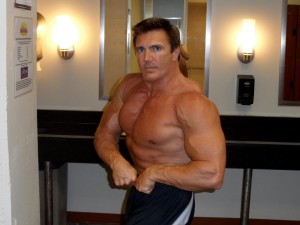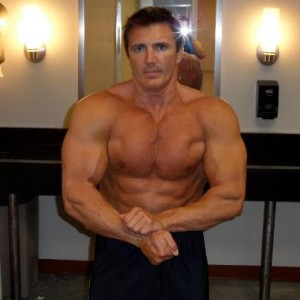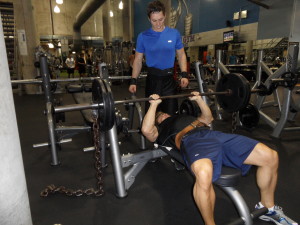Q. – “Hi John. I’ve been reading your Naturally Huge column in Ironman Magazine for years and I really enjoy it. I just finished a contest here in Florida and placed third. Do you think it’s a good idea to start bulking up for next year’s show? I noticed that you usually bulk up thirty or forty pounds in the off season. Do you think this is a good idea or should I try to stay lean? How high is your body fat percentage in the off season when you bulk up? Thanks for your help.”
A. – How much you “bulk up” in the off-season depends on what your physique goals are. If you are a young bodybuilder or are new to competition and you need to increase your overall muscle mass, then I think gaining extra weight in the off-season is an excellent method to help you add more size to your physique. In fact, it will be almost impossible to get much bigger from year to year by staying lean or in contest condition 12 months of the year.
Many bodybuilders misunderstand what is meant by “bulking up”. It’s not simply gorging yourself with as much food as possible. After all, we are physique artists, not sumo wrestlers. Your objective for bulking up should be to increase your overall muscle mass by forcing the body to take on new dimensions that have never been achieved before by your physique. You are looking to add muscle along with a little bit of fat before you diet back down for your next competition.
Of course, the ideal thing would be to gain all muscle and no bodyfat but the body doesn’t work like that. Putting on more muscle involves eating an excess of calories and other nutrients such as protein and carbohydrates. It also involves training that is very heavy and/or intense and the nutrition required to fuel and recover the body from this type of regimen must not be a limited amount of calories. If you are limiting the amount and types of foods you are eating, how can you ever hope to recuperate properly?
How much weight you gain in between competitions depends on your individual body. You have to be honest with yourself on what type of metabolism you have. If you are an ectomorph and find it very difficult to gain weight, you will not have to worry about limiting the amount of calories you eat in the off-season. You will most likely be able to eat anything you want in order to add some size during your bulking phase.
If you have a slower metabolism, however, then you will have to be very careful about gaining weight in the off-season. You don’t want to add so much extra weight (fat) that getting ready for your next contest will require a herculean effort in order to get back to that ripped look. Trying to lose too much fat before a competition puts your muscle mass at a great risk. This is obviously self-defeating. Endomorphs, or those with slow metabolisms, need to put on weight very slowly and really keep an eye on their waistlines at all times.
As you mentioned, I typically weigh 30-40 pounds more than my contest weight in the off-season. This bodyweight differential is based on how big of a bodybuilder you are and what type of metabolism you have. Many professional bodybuilders weigh over 300 pounds in the off-season and then compete between 240-250 pounds. This is a 50-60 pound difference but they are also very big guys. The goal to shoot for is to get as big as you can in the off-season without looking too fat. Always remember that your overall goal is to improve your physique for your next contest, not just to see how heavy you can get before you start your diet again.
My metabolism is pretty fast so I can lose fat without killing myself if I bulk up in the off-season. I don’t keep track of my bodyfat percentage in the off-season and I don’t even measure it when I am getting ready to compete. I go more by the mirror and the size of my waist. I will routinely take measurements of my waist both in the off-season and, especially, when I start my pre-contest diet. For me, a 32″ waist means I am ripped. Some bodybuilders may get down to a 27″ waist but they probably compete at a much lighter bodyweight and/or have a much smaller hip structure than I do.
During the off-season, I will eat many of the same foods that I eat when I am dieting but I will also eat other foods and I am much more relaxed about the amount of food that I eat. However, if I see that I am putting on too much fat compared to muscle, I will immediately cut back on my food intake. Again, my waistline measurement is a sure indicator. When my waist starts to creep over the 37″ mark, I limit my visits to the buffet restaurants.
The reason I bulk up during the off-season is because I have tried it both ways and I definitely make more improvements by gaining weight in between competitions than if I stay lean. When I carry a low percentage of bodyfat all the time, my muscles tend to flatten out when it’s time to start my pre-contest diet. Bulking up, however, allows me to not only train heavier but my muscles seem to look much fuller and thicker when I diet away all the excess bodyfat. I’m committed to making improvements in my physique and, if staying lean was the best way to accomplish this, then I would do that. For me, bulking up seems to work best.
Q. – “I am 5’5″ and weigh 170. I am trying to lose fat and gain muscle. How do I develop my inner and upper chest? I can never get the inner part. Sometimes I do declines and feel it all over and in the middle too. I believe my bodytype is endomorph. Every mistake you can name, I have done but I am learning. The most I have ever weighed was 180 after trying Size Surge 1, then I went up to 187. Right now I am 170. Should I do cardio even though muscle is better? I work out in the morning on an empty stomach. I eat 5 or 6 times a day. Should I multiply my weight by ten and then work my way down to that weight and start cardio then? What do I do when I want to bulk up? Please help me.”
A. – OK, let me answer your first question first. For the inner pecs, you need to do any type of chest pressing exercise using a narrow grip or an exercise where you can bring the wrists together. Doing the Bench Press or the Incline Bench Press with a grip width of about 8-9″ apart will work the inner pecs effectively. Since this hand spacing will also bring the triceps into play more than a wider grip will, I would recommend doing the standard Bench Press and Incline Press (with either barbells or dumbbells) before doing 3-4 sets of the narrow grip Bench Press. If you don’t feel this movement in the inner pecs, try doing the exercise on a Smith Machine to isolate that area of the chest.
The other type of exercise that affects the inner pecs is one where you can bring the hands or wrists together so the pectorals can fully contract. This will bring the inner pecs into play. Cable Cross-overs are a perfect movement for this part of the chest. You can do Cable Cross-overs standing or laying down on a flat or incline bench. If you try to contract the inner pecs with dumbbell flyes, the tension on the muscle will drop off before the inner pecs are fully contracted.
You mentioned that you feel declines in the inner pecs but decline presses and flyes are exercises that are designed to train the lower pecs. You may be using a narrow grip on the decline press and feeling the contraction in the inner pecs. A narrow grip on the bar will hit the inner pecs in either the decline, flat or incline position.
As for your other questions, you seem to be a little confused on what you are trying to accomplish. You mention that you want to lose fat and gain muscle. As you have no doubt already discovered, these are conflicting goals. In order to be successful, you need to concentrate on one goal at a time.
If you currently weigh 170 pounds and want to increase your size, I would suggest training no more than four days per week using the basic exercises. Use poundages that limit your reps between 6-10. Keep the amount of exercises and sets moderate to avoid over training. If you got such great results using the Size Surge program, perhaps you should go back to using that.
You mentioned that you train in the morning on an empty stomach. In order to train with the heaviest weights possible, you should eat something at least an hour before your training session. A protein shake with some oatmeal would be a good pre-workout meal. You will really notice the difference in your strength and energy levels after including this morning meal into your routine.
You should also avoid cardio in the off-season. Cardio exercise is effective for losing bodyfat but, if you are trying to get bigger, you need to concentrate on that first. Burning excess calories through aerobic exercise will compromise your primary goal of adding muscle mass and bodyweight. Remember, one goal at a time.
As for your nutrition program, you should begin by adding up exactly the amount of calories, carbs, protein and fats that you are consuming right now. Make sure you are eating at least 1.25 grams of protein for each pound of bodyweight and also analyze what types of carbs and fats you are eating on a daily basis.
Since you are maintaining your bodyweight of 170 pounds with your present diet, you will need to increase your calories in order to get bigger. Forget about multiplying your bodyweight by ten. Simply add 300 calories to your current diet and then monitor your body from there. If you are endomorphic, you will want to gain weight very slowly so you don’t gain too much bodyfat. The intense training you are doing should balance out the additional calories.
By writing down each workout and recording your diet every day, you will become more aware of what is working as you sculpt your physique. Soon, you will acquire the knowledge you need to build the body you desire. Good Luck!
Check out John Hansen’s New Training Program – MP6 Training – the ultimate cycling training program for adding both Power and Mass! Go to www.mp6training.com!























You must be logged in to post a comment Login